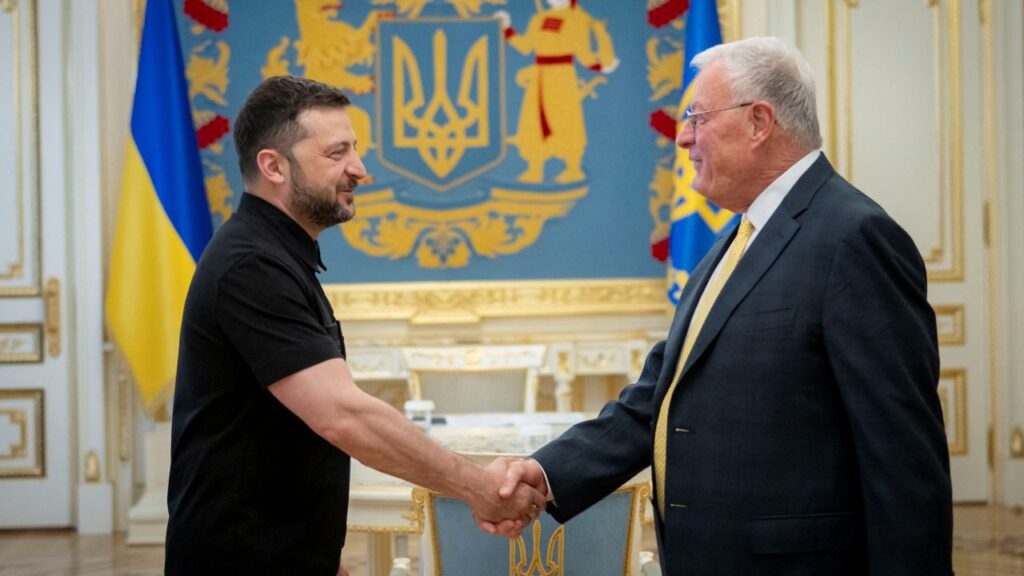Former President Donald Trump arrives to the Capitol Hill Club, Thursday, June 13, 2024, in Washington. (AP/Jacquelyn Martin)

- Donald Trump has claimed no knowledge of Project 2025 or its contributors, despite some of his allies being involved.
- Spearheaded by the Heritage Foundation, Project 2025 includes extreme executive-branch overhauls.
- Democrats criticize Project 2025 as an authoritarian blueprint, while some Republicans support its radical proposals.
Share
|
Getting your Trinity Audio player ready...
|
Donald Trump has gone to great lengths to distance himself from Project 2025, a set of conservative policy proposals for a future Republican administration that has outraged Democrats. He has claimed he knows nothing about it or the people involved in creating it.
Trump himself was not behind the project. But some of his allies were.
The document, its origins and the interplay between it and the Trump campaign have made for one of the most hotly debated questions of the 2024 race.
Here is what to know about Project 2025, and who is behind it.
What is Project 2025?
Project 2025 was spearheaded by the Heritage Foundation and like-minded conservative groups before Trump officially entered the 2024 race. The Heritage Foundation is a think tank that has shaped the personnel and policies of Republican administrations since the Reagan presidency.
The project was intended as a buffet of options for the Trump administration or any other Republican presidency. It’s the latest installment in the Heritage Foundation’s Mandate for Leadership series, which has compiled conservative policy proposals every few years since 1981. But no previous study has been as sweeping in its recommendations — or as widely discussed.
Kevin Roberts, the head of the Heritage Foundation, which began putting together the latest document in 2022, said he thought the U.S. government would embrace a more conservative era, one that he hoped Republicans would usher in.
Related Story: Nikki Haley Releases Delegates So They Can Back Donald Trump at the RNC
“We are in the process of the second American Revolution,” Roberts said on Real America’s Voice, a right-wing cable channel, in early July, adding pointedly that the revolt “will remain bloodless if the left allows it to be.”
A representative for Project 2025 said it did not speak for any candidate, adding that “it is ultimately up to that president, who we believe will be President Trump, to decide which recommendations to implement.”
What Does Project 2025 Propose?
Much of the plan’s nearly 900 pages detail extreme executive-branch overhauls. Among many recommendations, Project 2025 lays out plans for criminalizing pornography, disbanding the Commerce and Education departments, rejecting the idea of abortion as health care and shredding climate protections.
It calls out the National Oceanic and Atmospheric Administration, which includes the National Weather Service, as “one of the main drivers of the climate change alarm industry.” And it backs deploying the military “to assist in arrest operations” along the U.S.-Mexico border.
Beyond the policy proposals, something else comes up over and over again in the document — Trump and the Trump administration, which are mentioned hundreds of times.
Related Story: Trump Returns to Campaign Trail with VP Deadline Nearing Amid Calls for Biden ...
What are Trump’s Ties to Project 2025?
Project 2025 is led by the Heritage Foundation. It does not directly come from Trump. But that’s only part of the story.
Portions of the plan were driven by people who were top advisers to Trump during his first term and would most likely serve in prominent roles if he wins in November.
Russell T. Vought, Trump’s former budget director, led a section of Project 2025 that dealt with executive orders. Vought is the policy director for the Republican National Convention, and the national party is controlled by Trump allies. The party on Monday adopted a new policy platform that reflects priorities laid out on the Trump campaign website. Another person involved in Project 2025 is John McEntee, a former White House personnel chief who began Trump’s systematic attempt to sweep out officials deemed to be disloyal in 2020.
Related Story: Republicans Move at Trump’s Behest to Change How They Will Oppose
Trump has recently gone to great lengths to distance himself from the project, even falsely claiming that he knows nothing about it or people involved in it.
Trump wrote in a post on his social media site last week that he knew nothing about Project 2025 but also that he disagreed with parts of it: “Some of the things they’re saying are absolutely ridiculous and abysmal.” He did not specify which items he was talking about.
What are Trump’s Plans for a Second Term?
The former president has been historically disengaged, even hostile, toward any type of transition planning for a possible second term.
But he has made no secret about his plans to gut civil-service protections, conduct the largest mass deportation effort in history, impose sweeping tariffs and target his enemies using presidential powers. His allies have developed a legal rationale to erase the Justice Department’s independence from the president, and several of his closest advisers are now vetting lawyers seen as more likely to embrace aggressive legal theories about the scope of his power.
Some of this, though not all of it, can be found in the Trump campaign’s own policy platform called Agenda47. It is more sparse than Project 2025. And even though Agenda47 is his campaign’s official list of policy priorities, Trump himself rarely mentions Agenda47 by name on the campaign trail.
How do the Trump Campaign Plans and Project 2025 Differ, and Overlap?
There are a few ways the two plans differ.
One is on abortion. Project 2025 takes an aggressive approach to curtailing abortion rights, stating that the federal Health and Human Services Department “should return to being known as the Department of Life” (it was never known by that name) and that the next conservative president “has a moral responsibility to lead the nation in restoring a culture of life in America again.” Agenda47, however, does not mention abortion once.
Trump’s public position on abortion has regularly shifted. When he ran in 2016, he pledged to install justices who would overturn Roe v. Wade. He called the ruling that overturned it “a great thing” at the presidential debate this year. He also said at the debate that abortion rights should be decided on a state-by-state basis.
Despite the differences, there are numerous similarities. One overlap: eroding the independence of the Justice Department. Trump has frequently criticized the legitimacy of the department’s investigation into attempts to overturn the 2020 election. Project 2025 argues that the department suffers from bureaucratic bloat and must be reined in, teeming with employees committed to a “radical liberal agenda.” On immigration, Trump has made no secret of his plans to hold the largest mass deportation effort in history. Project 2025, likewise, suggested the removal of any and all “immigration violators.”
The campaign and Project 2025 also share equal demands to end diversity, equity and inclusion programs and the “toxic normalization of transgenderism” as Project 2025 calls it. In many rallies, Trump asserts he will “keep men out of women’s sports.”
On international policy, Trump and Project 2025 both emphasize a protectionist outlook, often called “America First” policies by the Trump campaign. Sections in Project 2025 and in Agenda47 both suggest higher tariffs on competitors, and increasing competition with China.
One of Project 2025’s proposals to turn more federal jobs over to appointees loyal to the president mirrors a Trump-era policy. The backstory: During Trump’s presidency, he issued an executive order making it easier to fire career officials and replace them with loyalists. President Joe Biden rescinded the order, known as Schedule F, but Trump has said he would reissue it if he wins a second term. Project 2025 also calls for Schedule F to be reinstated.
What are Democrats Saying About Project 2025?
Biden’s campaign and his supporters have yoked Project 2025 around Trump’s neck, repeatedly warning that it is his shadow platform and that it is evidence of an extreme second-term agenda. They have called it an authoritarian blueprint in an onslaught of news releases, social media posts and TV appearances.
In a rarity for an in-the-weeds policy memo, Project 2025 has made its way into the wider public, drawing condemnations on late-night shows, podcasts and awards programs. Since February, @BidenHQ, the campaign’s social media account, has posted about Project 2025 hundreds of times, associating it with Trump. The effort has received more engagement than most of the account’s posts, according to a Biden campaign official.
“Project 2025 should scare every single American,” Biden said in a statement. “It would give Trump limitless power over our daily lives.”
What are Trump’s Aides and Other Republicans Saying About Project 2025?
Last year, after Project 2025 gained traction in the media and the Biden campaign incorporated it as a core part of its messaging, top Trump campaign officials issued a statement.
Trump’s top aides, Susie Wiles and Chris LaCivita, said in a December statement that unless indicated by campaign staff or the former president directly, “no aspect of future presidential staffing or policy announcements should be deemed official.”
Wiles and LaCivita have been continually frustrated with press coverage of Project 2025. They see much of it as potentially damaging in a general election. They are especially anxious about anything to do with restrictions on abortion, a sign that Trump is trying to appear more moderate on the issue as his focus shifts from the GOP primary concerns of his base to the broader electorate in November.
Beyond the abortion issue, many conservatives do not contest the radical nature of Project 2025, and they embrace the publicity.
Steve Bannon, a close Trump ally, told ABC News in late June, before he reported to federal prison to begin a four-month sentence for contempt of Congress, that Project 2025 would “take apart the administrative state brick by brick” as he brandished a copy of the report.
–
This article originally appeared in The New York Times.
By Simon J. Levien
c.2024 The New York Times Company



















